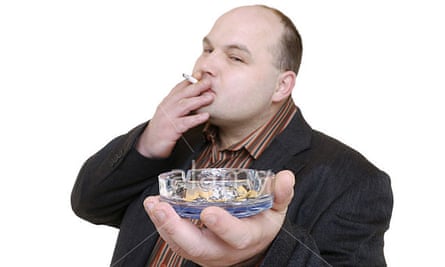As we were all getting to grips with the dreary onset of winter this week, carefully selecting what vices might help get us through, the World Health Organisation went and classified bacon and other delicious meats as carcinogens.
Cured and processed meats – bacon, salami, sausages – were classified as group 1 carcinogens along with tobacco, alcohol, arsenic and asbestos – because there is a causal link between eating these meats and bowel cancer. But let’s face it, apart from being dead there’s very little you can do to avoid carcinogens all together.
Modern life is packed with things that could reportedly cause cancer: alcohol, excess body fat, pollution, cleaning products, sun exposure, contraceptive pills, plastic tubs in the microwave and close contact with other humans – which increases the risk of contracting certain potentially cancer-causing viruses.
But even if you did knock back a chosen group 1 carcinogen all day, every day, there’s no guarantee that you’ll definitely get cancer either. So, is there any point in actively trying to avoid them? The answer is a very definite yes, and no.
Carcinogens are not all the same
It’s important to understand that not all carcinogens are the same. Eating one bacon sandwich is not equal to smoking one cigarette. So Ed Miliband, if you’re reading this, you do not need to worry.

Carcinogens do not cause cancer in every case, all the time. Substances labelled as carcinogens may have different levels of cancer-causing potential. Some may cause cancer only after prolonged, high levels of exposure. And the risk of developing cancer depends on many factors, including how you are exposed to the carcinogen, the length and intensity of exposure, and your genes.
Comparing every cancer-causing substance like for like is dangerous and deeply confusing to anyone trying to work out how to lead a healthy life. But, for example, lie naked in direct sunlight without sun protection for 10 years, smoke 100 cigarettes a day for 15 years, or actively become overweight and don’t exercise for 30 years, it’s safe to say that you could be putting yourself at unnecessary risk. But even then there’s still no guarantee you’ll die from cancer.
How do carcinogens cause cancer?
Cancer is caused by changes in a cell’s DNA. Some of these changes can be inherited, others may be caused by environmental factors – these are known as carcinogens.
Some carcinogens do not affect DNA directly, but lead to cancer in other ways by, for example, causing cells to divide at a faster than normal rate, which could increase the chance of altering DNA.
You might still get cancer
It’s estimated that more than 4 in 10 cancer cases in the UK can be prevented by lifestyle changes. The point of cutting out carcinogens is to lower your risk of getting cancer. But regardless of how carefully you try to limit your exposure to carcinogens, some people are genetically predisposed.
You might inherit damaged DNA from your parents – such as the BRCA genes that are linked with breast, ovarian and prostate cancers – which give you a higher risk of developing cancer.

There are lists and lists of cancer-causing agents. But few of them appear to apply to an average person’s every day life: “avoid auramine and be aware of the risks involved in making polychlorinated biphenyls”. Um, what?
Here’s a guide to some of the most obvious cancer-causing agents you’re likely to come across in your day-to-day life, so you can choose whether to avoid them or not.
Smoking
Yes, you’ve heard it before: stop smoking. Marine Le Pen smokes, as does Macauley Culkin; smoking just isn’t cool. At the risk of sounding like a public service announcement, here are some compelling facts.
Chemicals in cigarette smoke – specifically benzene, polonium-210, benzopyrene and nitrosamines – cause cancer by directly damaging our DNA including the genes that help protect us from cancer. Top work cigarettes!
The chemicals in cigarettes enter our blood stream which then get pumped around our bodies by our ever helpful hearts. This is why smoking also increases the risk of at least 13 other cancers including cancers of the larynx, oesophagus, mouth and pharynx, bladder, pancreas, kidney, liver, stomach, bowel, cervix, ovary, nose and sinuses and some types of leukaemia.
Smoking, according to absolutely everyone, is the biggest preventable cause of cancer in the world. It accounts for more than one in four cancer deaths, and four out of five lung cancer deaths, which has the lowest survival rate of any cancer. The WHO predicts that if smoking rates continue, tobacco will be responsible for for 1 billion deaths in the 21st century.
Alcohol
The only positive thing to say here is that it doesn’t matter if you binge drink or drink regularly in small quantities, alcohol can give you cancer.
When you drink alcohol, the cancer-causing chemical acetaldehyde is formed. And no type of alcohol is better or worse than another. Whether it’s premium vodka or a no-frills supermarket own, it is the alcohol itself that is the problem.
Acetaldehyde causes cancer by making our liver cells grow faster than normal. These regenerating liver cells are then more likely to pick up changes in their genes that could then lead to cancer. Alcohol can also affect the level of oestrogen in our bodies, and high levels of this hormone can increase the risk of breast cancer.

Not everyone who drinks alcohol will develop cancer. But research has found that some cancers – mouth, throat, oesophageal, breast and bowel – are more common in people who drink more alcohol than others.
Meat
As of this week, processed and cured meat is officially a group 1 carcinogen. But the way meat is cooked can also expose us to cancer-causing chemicals, specifically heterocyclic amines (HCAs) and polycyclic aromatic hydrocarbons (PAHs).
These chemicals are formed when meat is cooked using high-temperature methods, especially at temperatures of above 149C, such as frying or grilling over an open flame. Meats cooked at high temperatures or for a long time tend to form more HCAs. Smoked or charred meats create PAH. HCAs and PAHs damage DNA after they are metabolised by enzymes in the body, a process known as bioactivation.
Population studies have not established a definitive link between HCA and PAH exposure from cooked meats and cancer in humans. But some epidemiologic studies found that high consumption of well-done, fried, or barbecued meats was associated with increased risks of colorectal, pancreatic, and prostate cancer.
Having excess body fat tissue
There are no clear answers to why being overweight causes cancer, but it’s mainly to do with the idea that fat tissue produces hormones and proteins that make other cells behave differently. And this could cause cancerous cells to grow.

Fat tissue produces hormones such as insulin or oestrogen. These are then released into our bloodstream and carried around the body. Excess fat tissue changes the levels of sex hormones, oestrogen and testosterone, which may increase the risk of cancer. And high insulin levels are a common feature of many cancers.
Large amounts of belly fat can do even more damage and this indicator is linked to bowel, kidney, oesophageal, pancreatic, breast, and womb cancers. It isn’t clear exactly why this is, but it could be to do with how quickly the chemicals from the fat can get into the blood.
HPV virus
Human papilloma virus (HPV) is a very common infection which usually causes no symptoms. Up to 8 out of 10 people will be infected with the virus at some point in their lives. Most types of HPV are harmless, but around 13 types can cause cancer.
The virus infects the skin and the cells lining body cavities through close skin-to-skin contact, including sex. During an infection, HPV causes skin cells to divide more than usual. New virus particles are then made inside these cells. Nearly all cervical cancers are caused by HPV, but it can also cause vagina, vulva, penis and anus cancers as well as some types of cancer in the mouth and throat.
Girls aged 12-13 are now given a vaccination, which prevents cervical cell changes, against the two most common ‘high-risk’ types of HPV, HPV 16 and 18. Using a condom can help prevent the transmission of HPV.
Sunlight
Yes, that lovely yellow ball that you so loved drawing with crayon as a child can give you cancer.

UVA and UVB from the sun and sunbeds, damage the DNA in our skin cells. Sunbeds give off UVA and UVB, but the mixture of the two is different to natural sunlight and is often much stronger. If enough DNA damage builds up over time, it can cause cells to start growing out of control, which can lead to skin cancer.
What you need to do is not get sunburned. Sunburn is a sign that you’ve damaged the DNA in your skin cells. If your skin has gone pink or red in the sun, it’s classed as sunburn. Your skin does not have to be hanging off and bleeding to indicate dangerous levels of damage. Getting painful sunburn, just once every two years, can triple your risk of melanoma skin cancer.

Comments (…)
Sign in or create your Guardian account to join the discussion